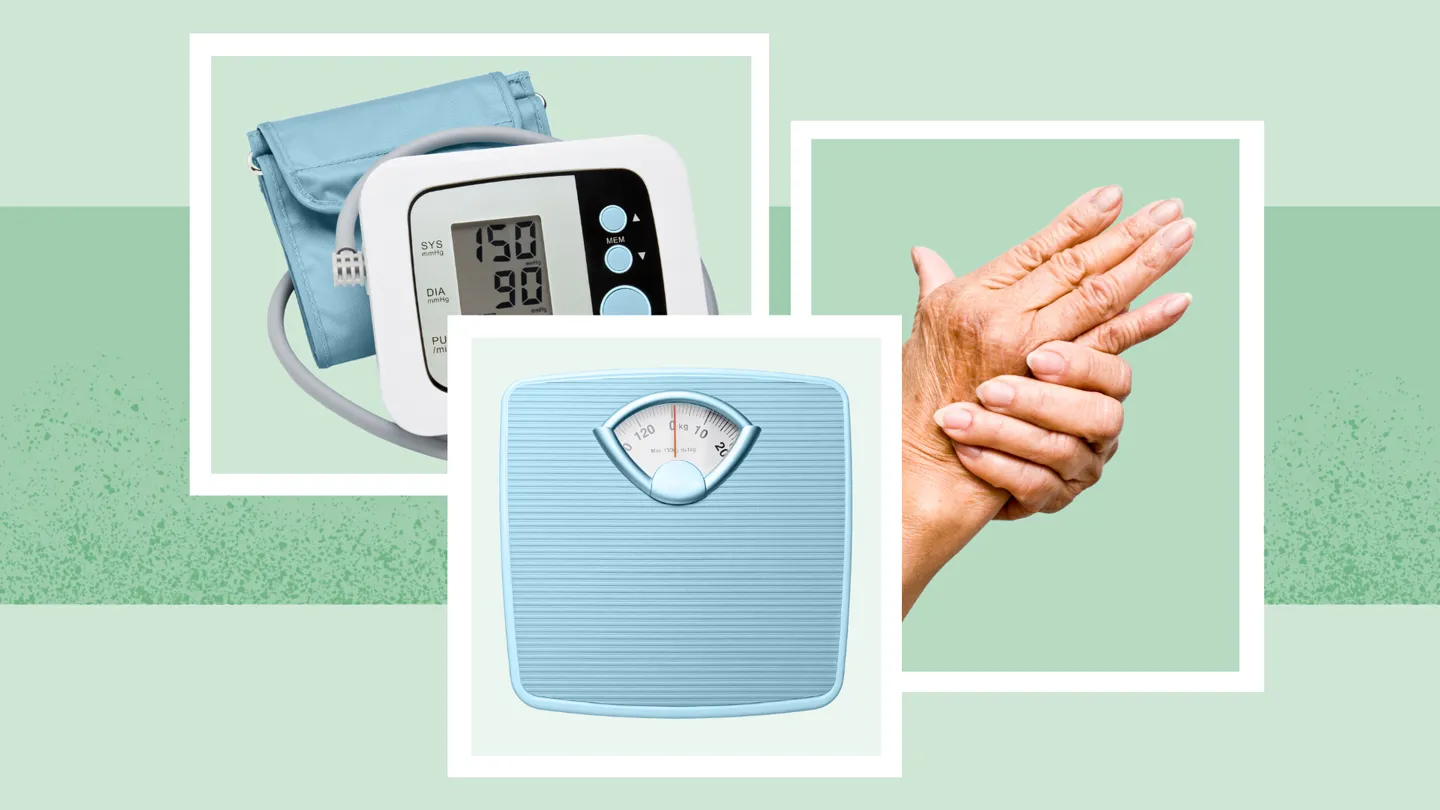But for most of us, the goal isn’t simply to live as long as possible — it’s to extend what experts call our “health span,” which is the number of healthy and disease-free years that we live.
And that gets more difficult with each year that we age. In fact, aging is the major uncontrollable risk factor for chronic disease, says John Batsis, MD, geriatrician at UNC Health and associate professor at the UNC School of Medicine in Chapel Hill, North Carolina.
But why does our risk go up as we get older, even if we have the same lifestyle habits that we did when we were younger — or even make some improvements?
As we get older, our bodies go through a series of natural processes that increase the risk of many conditions, says Jamehl Demons Shegog, MD, geriatrician at Atrium Wake Forest Baptist and associate professor of internal medicine at Wake Forest University School of Medicine, both in Winston-Salem, North Carolina.
“Aging isn’t just about one single disease or condition — it’s an ongoing process where our bodies change over time,” says Dr. Shegog.
Researchers continue to study the exact mechanisms behind aging, and there are multiple factors that come into play. Over time, our cells do not repair themselves as efficiently as they once did, making us more susceptible to some diseases, Shegog says. The cumulative effects of daily living, called oxidative stress, and natural hormonal changes can also increase the risk of chronic disease.
But even though aging and all that comes with it may increase the likelihood of chronic conditions, there are ways to limit your risk and manage any health conditions that you may develop.
1. High Blood Pressure (Hypertension)
“High blood pressure can exist without any symptoms. It can remain undiagnosed until it leads to more severe complications, such as a heart attack, stroke, or dementia. These serious conditions can develop undetected over time, making hypertension a hidden threat,” says Shegog.
Studies have shown that properly managing hypertension can lower the likelihood of heart failure, stroke, and dementia by 20 to 40 percent, she adds.
2. High Cholesterol
3. Obesity
Obesity is a complex condition that is influenced by many factors, including genetics, lifestyle habits, and environmental and social determinants of health. It is usually defined as having too much body fat, with a body mass index of 30 or higher. More than 40 percent of American adults ages 60 and older meet that definition.
There’s evidence that some medical disorders actually come in clusters, often due to underlying biology and metabolic changes, such as obesity, says Dr. Batsis.
Having obesity is linked with many health conditions, including hypertension, type 2 diabetes, cardiovascular disease, arthritis, dementia, and certain types of cancer.
4. Arthritis
Arthritis is a chronic condition that causes damage in the joints, the place in the body where two bones meet. Not surprisingly, the most common type of arthritis in older adults is osteoarthritis, also called “wear and tear” arthritis.
5. Coronary Artery Disease
Coronary artery disease (CAD), also called ischemic heart disease, is the most common type of heart disease. Over time, fats and cholesterol can build up and narrow the arteries; it’s the kind of condition that can progress silently over years and suddenly show up in the form of chest pain or a heart attack.
6. Diabetes
Diabetes is one of many conditions that tends to go hand in hand with other conditions such as heart disease, high blood pressure, and obesity, says Shegog.
“This is because they share common risk factors, including poor diet, lack of physical activity, and genetic predisposition. When one of these conditions develops, it can trigger or exacerbate others, creating a cycle of worsening health,” she says.
Managing those risk factors is key in preventing diabetes. Following a plant-based diet that includes fiber-rich fruits, vegetables, whole grains, and legumes, while limiting processed and ultra-processed foods, is a great way to optimize your metabolic health and reduce diabetes risk.
If lifestyle changes aren’t enough to keep your blood sugar levels in the desired range, there are many treatment options, including GLP-1 agonists.
7. Chronic Kidney Disease
Chronic kidney disease (CKD) doesn’t get as much attention as some other chronic conditions, but it affects more than 33 percent of people over 65. In CKD, the kidneys have been damaged over time and eventually lose their ability to filter waste from the blood, which can lead to other health issues such as anemia, recurrent infections, cardiovascular disease, and even kidney failure.
8. Heart Failure
Heart failure doesn’t mean your heart has stopped working, but it does mean it’s not pumping blood as well as it should.
9. Depression
There are many reasons depression becomes more common in older populations. Medical conditions such as stroke and cancer, a family history of depression, and physical limitations that keep you from doing some of the things you used to do can all increase the risk of depression.
However, depression is often written off or even goes undiagnosed in older people because of the mistaken belief that it’s a normal part of aging. It is not, and there are things you can do about it.
“Staying involved in your community, and maintaining relationships is important. Loneliness and isolation can contribute to depression, which can, in turn, worsen physical health and increase the risk of developing or exacerbating medical conditions,” says Shegog. In fact, loneliness and isolation have been shown to carry health risks comparable to smoking and obesity.
Getting help for depression is essential. If your mood begins to get in the way of your ability to go about your daily activities, talk with your healthcare provider about options such as therapy, a support group, or medications.
10. Alzheimer’s Disease and Other Dementias
The risk of Alzheimer’s and other forms of dementia gets higher as we grow older. These conditions can slowly erode memory, thinking skills, and the ability to manage daily life.
Researchers are still trying to understand why Alzheimer’s mostly affects older adults. It could be a combination of many age-related changes in the brain, including the shrinking of certain brain regions, inflammation, and blood vessel damage.
While there’s no cure, emerging research shows that there are ways to reduce your risk or slow dementia’s progression. Staying physically active, getting plenty of sleep, keeping your mind engaged, and following a brain-healthy diet (such as the Mediterranean diet) are all smart moves.
Regular Checkups and Screenings Can Help
“Regular visits to your healthcare provider for checkups and screenings are essential for detecting hidden problems early,” says Shegog. In most cases, diseases that are detected early in their course can be treated more effectively than those diagnosed late.
For older people, regular screenings should include cognitive screenings, fall risk assessments, and frailty evaluations, as well as routine screenings for the health concerns listed above.
If you are diagnosed with a complex medical condition, such as heart failure or Alzheimer’s disease, having goal-oriented conversations with your healthcare team can help guide treatment decisions, especially in cases where the condition may progress or impact daily life.
It’s also important to stay up to date on recommended vaccinations, such as the flu shot and pneumonia (pneumococcal) vaccine.
“Immunity tends to decline over time,” says Shegog, which makes older people more susceptible to infections and their complications.
Completing advance directives is another important part of proactive care for older individuals.
The Takeaway
- While aging increases the risk of chronic diseases, there are many effective ways to manage and even prevent conditions such as high blood pressure, diabetes, and arthritis.
- Maintaining a healthy diet, staying physically active, and avoiding smoking can significantly lower the risk of many common conditions, including heart disease, obesity, and dementia.
- Depression and cognitive decline are not inevitable parts of aging. Early recognition and seeking help through therapy, peer support, or medical treatment can greatly improve quality of life.
- Regular checkups with your healthcare provider and staying on top of the recommended screenings and vaccinations are powerful tools for extending not just lifespan but also health span.
Read the full article here




